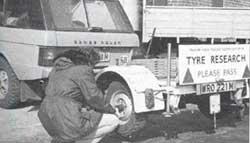Burning rubber
 NEW generation dream tyres may add zip and more traction to highway driving, but several countries fear they could just skid into nightmare zones. The menace assumes various forms: discarded tyres clutter the roadsides, clog the coasts, or give off noxious fumes when burned. And tyre production is still rolling on at breakneck speed. Western Europe alone produces about 200 million tyres a year; the us accounts for 237 million, and Japan for 140 million. To counter the environmental threat, harassed European countries have enacted tough legislations to prevent the indiscriminate dumping of scrap tyres.
NEW generation dream tyres may add zip and more traction to highway driving, but several countries fear they could just skid into nightmare zones. The menace assumes various forms: discarded tyres clutter the roadsides, clog the coasts, or give off noxious fumes when burned. And tyre production is still rolling on at breakneck speed. Western Europe alone produces about 200 million tyres a year; the us accounts for 237 million, and Japan for 140 million. To counter the environmental threat, harassed European countries have enacted tough legislations to prevent the indiscriminate dumping of scrap tyres.
In Germany, municipal tips for dumping tyres are now prohibited. If dumped at all, it is for a fee, before they are disposed of to a specialist user. The tyre industry will be compelled to bear the costs of disposal and collection from dealers.
Likewise, the uk has prohibited overground scrap tyre storage because of possible fire and other environmental hazards. As a further precaution, its department of environment has advised landfill sites to limit the proportion of scrap tyres to 5 per cent of the total landfill volume.
In 1991, the European Community's (EC) expert committee identified tyres as a "priority waste stream" on which to take action, and proposed stiff targets for tyre recovery and recycling. In late 1993, the committee came up with radical suggestions: mandatory retreading of 25 per cent of tyres, and recyling and incineration of 65 per cent. The remaining 10 per cent would be handled through "prevention" -- giving tyres a longer life by ad 2000, so that the quantity of scrap released each year is minimised. The underpinning of these targets was a ban on landfilling whole tyres by 1996, and shredded tyres by AD 2000. However, the ec has been stopped in its tracks by wranglings in Brussels where the debate on whether the proposals should have a fullscale directive status to be enacted into national law, is on.
Disposal problems have, however, propelled several countries into refining major applications. Some manufacturers, for instance, push for retreading. "Retreadability is a very important commercial consideration for truck tyres," maintains Maurizio Prete, an ec committee member and head of the truck tyres division of Italy's Pirelli group. Similarly, France's Michelin, the world's largest tyre manufacturer, has pioneered the use of rubber powder from scrap tyres to coat road surfaces.
Even as tyre manufacturers seek to devise new scrap applications, observers feel that future research will have to focus on slashing the number of used tyres dumped each year. That translates into more durable products with less friction -- a welcome spinoff from a skittish waste disposal conundrum.
Related Content
- Affidavit filed by the Rajasthan State Pollution Control Board illegal and polluting kilns/crucibles along the Haryana-Rajasthan border near the Aravalli range, 01/05/2025
- Order of the National Green Tribunal regarding illegal scrap kilns operating in Aravallis, 22/01/2025
- Final report by PPCB on management of scrap at Mandi Gobindgarh, district Fatehgarh Sahib, Punjab, 01/04/2021
- Order of the National Green Tribunal regarding pollution by a rubber factory, village Ikkas, district Jind, Haryana, 15/06/2020
- Order of the National Green Tribunal regarding cement industry pollution, Sikandrabad, District Bulandshahr, Uttar Pradesh, 18/09/2019
- Order of the National Green Tribunal regarding pollution caused by M/s Valley Iron & Steel Company, Sirmaur, Himachal Pradesh, 01/07/2019
